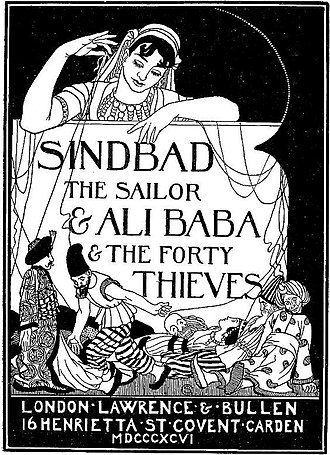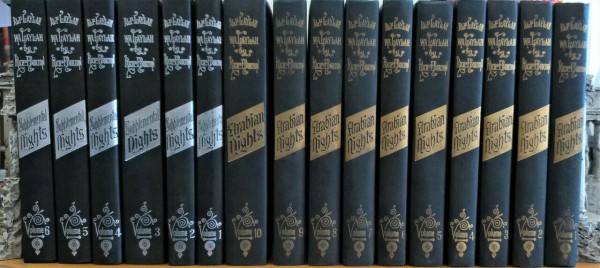The history of Arabian Nights is both long and complex, and to try to actually compare the many translations is more than we can manage. Our goal for this page is to introduce a selection of excellent English retellings, primarily for children. To that end, we're compiling a list of both editors/retellers and illustrators, some of whose illustrations have been reused in various places.
The stories have gone by various names, but One Thousand and One Nights is closer to original Arabic title of Alf Layla wa-Layla. Since there are, truly, at least 1,001 tales, retellings are of necessity selections, so it's important to evaluate which tales are included. Interestingly, some of the stories most commonly associated with the Arabian Nights—particularly "Aladdin's Wonderful Lamp" and "Ali Baba and the Forty Thieves"—weren't part of the collection in its original Arabic versions. They were added in Frenchman Antoine Galland's first European version (1709-1717) after he heard them from the Syrian Maronite Christian storyteller Hanna Diab during Diab's visit to Paris. Other stories, such as "The Seven Voyages of Sinbad the Sailor", also had an independent existence before being added to the collection.
Modern translations (Source: Wikipedia)
Main article: Translations of One Thousand and One Nights

Sindbad the Sailor and Ali Baba and the Forty Thieves by William Strang, 1896
The first European version (1704–1717) was translated into French by Antoine Galland from an Arabic text of the Syrian recension and other sources. This 12-volume work, Les Mille et une nuits, contes arabes traduits en français ('The Thousand and one nights, Arab stories translated into French'), included stories that were not in the original Arabic manuscript. "Aladdin's Lamp", and "Ali Baba and the Forty Thieves" (as well as several other lesser-known tales) appeared first in Galland's translation and cannot be found in any of the original manuscripts. He wrote that he heard them from the Christian Maronite storyteller Hanna Diab during Diab's visit to Paris. Galland's version of the Nights was immensely popular throughout Europe, and later versions were issued by Galland's publisher using Galland's name without his consent.
As scholars were looking for the presumed "complete" and "original" form of the Nights, they naturally turned to the more voluminous texts of the Egyptian recension, which soon came to be viewed as the "standard version". The first translations of this kind, such as that of Edward Lane's One Thousand and One Nights (1840, revised in 1859, illustrations by Joseph Smith), were bowdlerized. Unabridged and unexpurgated translations were made, first by John Payne, under the title The Book of the Thousand Nights and One Night (1882, nine volumes), and then in 1885 by Sir Richard Francis Burton, entitled The Book of the Thousand Nights and a Night (1001 stories in ten volumes, plus six supplemental volumes)—the latter was, according to some assessments, partially based on the former, leading to charges of plagiarism.

In view of the sexual imagery in the source texts (which Burton emphasized even further, especially by adding extensive footnotes and appendices on Oriental sexual mores) and the strict Victorian laws on obscene material, both of these translations were printed as private editions for subscribers only, rather than published in the usual manner. Burton's original 10 volumes were followed by a further six (seven in the Baghdad Edition and perhaps others) entitled The Supplemental Nights to the Thousand Nights and a Night, which were printed between 1886 and 1888. It has, however, been criticized for its "archaic language and extravagant idiom" and "obsessive focus on sexuality" (and has even been called an "eccentric ego-trip" and a "highly personal reworking of the text").
Later versions of the Nights include that of the French doctor J.C. Mardrus, issued from 1898 to 1904. It was translated into English by Powys Mathers, and issued in 1923. Like Payne's and Burton's texts, it is based on the Egyptian recension and retains the erotic material, indeed expanding on it, but it has been criticized for inaccuracy.
Muhsin Mahdi's 1984 Leiden edition, based on the Galland Manuscript, was rendered into English by Husain Haddawy (1990). This translation has been praised as "very readable" and "strongly recommended for anyone who wishes to taste the authentic flavour of those tales." An additional second volume of Arabian nights translated by Haddawy, composed of popular tales not present in the Leiden edition, was published in 1995. Both volumes were the basis for a single-volume reprint of selected tales of Haddawy's translations.
In 2008 a new English translation was published by Penguin Classics in three volumes. It is translated by Malcolm C. Lyons and Ursula Lyons with introduction and annotations by Robert Irwin. This is the first complete translation of the Macnaghten or Calcutta II edition (Egyptian recension) since Burton's. It contains, in addition to the standard text of 1001 Nights, the so-called "orphan stories" of Aladdin and Ali Baba as well as an alternative ending to The seventh journey of Sindbad from Antoine Galland's original French. As the translator himself notes in his preface to the three volumes, "[N]o attempt has been made to superimpose on the translation changes that would be needed to 'rectify' ... accretions, ... repetitions, non sequiturs and confusions that mark the present text," and the work is a "representation of what is primarily oral literature, appealing to the ear rather than the eye." The Lyons translation includes all the poetry (in plain prose paraphrase) but does not attempt to reproduce in English the internal rhyming of some prose sections of the original Arabic. Moreover, it streamlines somewhat and has cuts. In this sense it is not, as claimed, a complete translation.
In 2021 yet another translation by Yasmine Seale was published by Liveright Publishing Corp (a division of W. W. Norton). This Annotated Arabian Nights is far less complete, but offers a great deal of information written by Paulo Lemos Horta, and an afterword by the aforementioned Robert Irwin. The stories are taken from the original Arabic, from the French, and from the Hanna Diyab tales. It also delves into the history of translations and retellings, offering a snapshot of the influence this book has had on such diverse authors and poets as Charles Dickens, Christina Rosetti, Edgar Allan Poe, O. Henry, and H.P. Lovecraft.
RETELLINGS WE'RE WORKING TO COMPARE:
1899: Arabian Nights Entertainments, by William Heath Robinson, Helen Stratton, A.D. McCormick (illustrated by A.L. Davis & A.E. Norbury)
1898: Arabian Nights Entertainments, by Andrew Lang (first illustrated by H. J. Ford, later by Vera Bock)
1907: Stories from the Arabian Nights, retold by Laurence Housman (originally illustrated by Edmund Dulac; later, in 1955, by Girard Goodenow for the Junior Deluxe Library)
1907: Aladdin and Other Tales from the Arabian Nights (illustrated by William Heath Robinson)
1909: The Arabian Nights: Their Best Known Tales, edited by Kate Douglas Wiggin & Nora A. Smith (illustrated by Maxfield Parrish)
1911: The Arabian Nights, by WHD Rouse (illustrated by Walter Paget)
1914: Arabian Nights, anonymous (illustrated by Milo Winter)
1916: Arabian Nights Entertainments, by Louis Rhead (also illustrated)
1917: The Arabian Nights, Rene Bull (illustrator)
1919: Aladdin and His Wonderful Lamp in Rhyme, by Arthur Ransome (illustrated by Thomas Mackenzie)
1923: The Arabian Nights: Tales of Wonder and Magnificence, retold by Padraic Colum (illustrated first by Eric Pape and later by Lynd Ward)
1925: Arabian Nights, by Orton Lowe (illustrated by Adeline H. Bolton)
1941: Tales from the Arabian Nights, adapted by Frances Jenkins Olcott (illustrated by Joseph Smith)
1946: Arabian Nights (Illustrated Junior Library) Earle Goodenow (illustrator) Series 1 | Series 2 | Series 3 | Series 4
1949: Seven Voyages of Sinbad the Sailor, from the 1898-1904 French text by J. C. Mardus, translated in 1923 by Powys Mathers (introduced by C. S. Forster and illustrated by Edward A. Wilson)
1951: Fairy Tales from the Arabian Nights, retold by E. Dixon (illustrated by Joan Kiddell-Monroe)
1957: Arabian Nights, retold by Amabel Williams-Ellis (illustrated by Pauline Baynes)
1957: Tenggren's Golden Tales from the Arabian Nights, retold by Margaret Seifer and Irving Shapiro (illustrated by Gustaf Tenggren)
1962: Lion and the Carpenter and Other Tales from the Arabian Nights, retold by Jean Stafford (illustrated by Sandro Nardini)
1963: Arabian Nights (Companion Library) (illustrated by Mamoru Funai)
1977: Tales from the Thousand and One Nights, by N.J. Dawood (illustrated by William Harvey)
1980s: Arabian Nights, retold by Brian Alderson (illustrated by Michael Foreman)
1982: One Thousand and One Arabian Nights, retold by Geraldine McCaughrean (originally illustrated by Stephen Lavis)
1985: Tales from the Arabian Nights, retold by James Riordan (illustrated by Victor G. Ambrus)
1987: Stories from the Arabian Nights, retold by Naomi Lewis (illustrated by Anton Pieck)
1988: Tales from 1001 Nights, adapted by Peter Oilver (illustrated by Tessa Hamilton)
1995: Arabian Nights: Three Tales, by Deborah Nourse Lattimore (reteller & illustrator)
2013: Tales from the Arabian Nights, by Val Biro (reteller & illustrator)
2021: Annotated Arabian Nights, Paulo Lemos Horta, translated by Yasmine Seale
Did you find this review helpful?